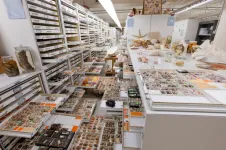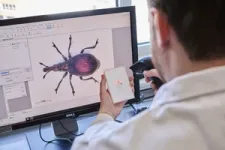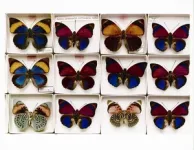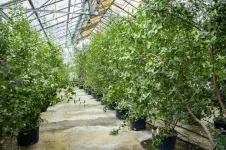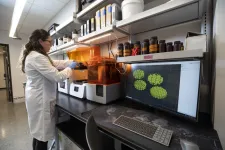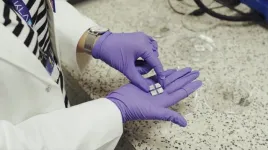(Press-News.org) March 23, 2023 – Washington, DC, New York, NY, and London, England – A group of natural history museums, organized by the Smithsonian National Museum of Natural History in Washington DC, the American Museum of Natural History Museum in New York City, and the Natural History Museum in London, has mapped the total collections from 73 of the world’s largest natural history museums in 28 countries. This is the first step of an ambitious effort to inventory global holdings that can help scientists and decisionmakers find solutions to urgent, wide-ranging issues such as climate change, food insecurity, human health, pandemic preparedness, and wildlife conservation.
Beyond the walls of their public galleries, the world’s natural history museums serve as the guardians of an unprecedented archive of the history of our planet and solar system. These natural history collections provide a unique window into the planet’s past, and they are increasingly being used to make actionable forecasts to chart our future. Museums have traditionally acted as independent organizations, but this new approach imagines a global collection composed of all the collections of all the world’s museums.
To better understand this immense, untapped resource, lead scientists from a dozen large natural history museums created an innovative but simple framework to rapidly evaluate the size and composition of natural history museum collections globally. The findings were published today in Science magazine in the paper, “A Global Approach for Natural History Museum Collections.” The Science paper can be found online at the Science press package at https://www.eurekalert.org/press/scipak/.
The survey organizers created a methodology that could rapidly survey collection holdings across museums by creating a common vocabulary of 19 collection types spanning the entirety of biological, geological, paleontological, and anthropological collections and 16 terrestrial and marine regions that cover the entirety of the Earth.
“We wanted to find a fast way to estimate the size and composition of the global collection so that we could begin to build a collective strategy for the future,” said lead author Kirk Johnson, Sant Director of the Smithsonian National Museum of Natural History. Johnson co-led the effort along with Ian F. P. Owens (formerly at the Natural History Museum in London and now the Executive Director of the Cornell Laboratory of Ornithology) in collaboration with more than 150 museum directors and scientists representing 73 natural history museums and herbaria.
The survey confirmed an aggregate collection of more than 1.1 billion objects, managed by more than 4,500 science staff and nearly 4,000 volunteers. While the aggregate collection is vast, the survey showed that there are conspicuous gaps across museum collections in areas including tropic and polar regions, marine systems, and undiscovered arthropod and microbial diversity. These gaps could provide a roadmap for coordinated collecting efforts going forward.
The report is a significant summary, but it is only the first step in surveying the global collection and tapping its enormous potential. Natural history collections are uniquely positioned to inform responses to today’s interlocking crises, but due to lack of funding and coordination, the information embedded in museum collections remains largely inaccessible. With strategic coordination, a global collection has the potential to guide decisions that will shape the future of humanity and biodiversity.
By creating this framework and survey, project organizers aim to create a foundation for the global museum network to work together to support future global sustainability, biodiversity, and climate frameworks using knowledge gained from museum collections. This will enable all museums to be more strategic as they plan their collection efforts in the future.
The authors also recognize that the historic concentration of large museums in North America and Europe can be a barrier to knowledge-sharing and perpetuates power imbalances rooted in the colonial history of museum science. In the future, it is crucial that the global collection also reflect and support museums elsewhere in the world.
“Natural history collections are the evidence from which scientists derive knowledge, including knowledge that can be applied to critical issues facing our planet today.” said Michael Novacek, curator in the Division of Paleontology and former provost of science at the American Museum of Natural History. “This has never been more urgent than today, as global biodiversity loss and climate change are accelerating.”
“This global view of natural science collections emphasizes their combined potential to help us act in response to the planetary crisis. It also demonstrates an ongoing commitment and responsibility to build equitable international collaboration and capacity with partners from all countries, harnessing the latest technological advances to further scientific understanding and make data available for all. This vast and progressively united infrastructure of collections and expertise represents a crucial resource in scientific understanding and prediction of global change, supporting action to avoid disaster,” said Doug Gurr, Director of the Natural History Museum in London.
The paper considers applications of collection-based research, focusing on case studies that explore how museum natural history collections can be used to study pandemic preparedness, global change, biodiversity, invasive species, colonial heritage, and museomics (study of DNA from museum specimens). Case study examples of each of the above applications are available here: https://bit.ly/3Ts2ZSm
As the authors write, “The long-term security and value of natural history collections depends on developing global and local partnerships that demonstrate not only their relevance for specific scientific, societal, and conservation challenges, but also for the benefits that apply to every person on the planet.”
The full Global Collections dashboard is available here: https://rebrand.ly/global-collections.
Images that address some of the issues raised in the paper can be found here: https://bit.ly/3Ts2ZSm
The full list of participating institutions and authors can be found here: https://bit.ly/3Ts2ZSm
About the National Museum of Natural History in Washington, DC
The National Museum of Natural History is connecting people everywhere with Earth’s unfolding story. It is one of the most visited natural history museums in the world. Opened in 1910, the museum is dedicated to maintaining and preserving the world’s most extensive collection of natural history specimens and human artifacts.
About the American Museum of Natural History in New York City
The American Museum of Natural History is one of the world’s preeminent scientific and cultural institutions. The Museum encompasses more than 40 permanent exhibition halls and galleries for temporary exhibitions, the Rose Center for Earth and Space and the Hayden Planetarium, and the Richard Gilder Center for Science, Education, and Innovation, opening in 2023. The Museum’s scientists draw on a permanent collection of more than 34 million specimens and artifacts.
About the Natural History Museum in London
The Natural History Museum is both a world-leading science research centre and the most-visited indoor attraction in the UK last year. With a vision of a future in which both people and the planet thrive, it is uniquely positioned to be a powerful champion for balancing humanity’s needs with those of the natural world.
END
Global natural history initiative builds groundbreaking database to address 21st century challenges
Effort connects more than a billion objects in scientific collections across 73 museums in 28 countries
2023-03-23
ELSE PRESS RELEASES FROM THIS DATE:
Eye color genes are critical for retinal health
2023-03-23
Metabolic pathways consist of a series of biochemical reactions in cells that convert a starting component into other products. There is growing evidence that metabolic pathways coupled with external stress factors influence the health of cells and tissues. Many human diseases, including retinal or neurodegenerative diseases, are associated with imbalances in metabolic pathways. Elisabeth Knust leads a team of researchers from the Max Planck Institute of Molecular Cell Biology and Genetics (MPI-CBG) in Dresden, Germany, who describe an essential role for one ...
Can insights from the soapbark tree change the way we make vaccines?
2023-03-23
The medicinal secrets of the Chilean soapbark tree have been laid bare, unlocking a future of more potent, affordable, and sustainably sought vaccines.
The evergreen species, Quillaja saponaria has, for decades, been highly prized for producing molecules called QS saponins, which are used in the food and drinks industry as foaming agents.
More recently an important new function has emerged with saponins obtained from the tree’s bark used as potent adjuvants in the production of vaccines. Adjuvants play a critical role in some vaccines, working to boost the potency of a vaccine by enhancing the host immune response.
Molecules extracted from soapbark tree are ...
Autism rates continue to rise in California
2023-03-23
A new report from the Centers for Disease Control and Prevention (CDC) shows the rates and demographics of children with autism spectrum disorder (ASD) are changing in the United States.
In the latest analysis, 1 in 36 8-year-old children (2.8%) have been identified as having ASD. This figure is higher than the previous estimate published in December 2021, which found a prevalence of 1 in 44 (2.3%) children, and considerably higher than the CDC’s first autism prevalence report published in 2007 noting a prevalence of 1 in 150 (0.7%).
Prevalence estimates also differed across the 11 data collection sites, ranging from 1 in 43 children (2.3%) in Maryland, to 1 in 22 (4.5%) ...
Artificial intelligence predicts genetics of cancerous brain tumors in under 90 seconds
2023-03-23
Using artificial intelligence, researchers have discovered how to screen for genetic mutations in cancerous brain tumors in under 90 seconds — and possibly streamline the diagnosis and treatment of gliomas, a study suggests.
A team of neurosurgeons and engineers at Michigan Medicine, in collaboration with investigators from New York University, University of California, San Francisco and others, developed an AI-based diagnostic screening system called DeepGlioma that uses rapid imaging to analyze tumor specimens taken during an operation and detect genetic mutations more rapidly.
In a study of more than 150 patients ...
SLU research finds improved wastewater treatment could lead to significant reduction in greenhouse gas emissions
2023-03-23
ST. LOUIS – Research published in Environmental Research Letters has shown that methane emissions from urban areas are underestimated by a factor of three to four and that untreated wastewater may be a contributing factor.
The study, “Investigating high methane emissions from urban areas detected by TROPOMI and their association with untreated wastewater,” was led by Benjamin de Foy, Ph.D., professor of Earth and Atmospheric Sciences at Saint Louis University, and published online on ...
What really matters in multi-story building design?
2023-03-23
The impact of multi-storey building design considerations on embodied carbon emissions, cost, and operational energy has been revealed for the first time.
Using a computer model, researchers estimate that up to six gigatonnes of carbon could be saved by 2050 if new multi-storey buildings follow certain recommendations during the design process. All these recommendations, which could also save between 28 and 44% of annual heating and cooling costs, use technology that is currently available.
Construction and operation of buildings account for more than one-third ...
UTEP joins project to 3D print batteries from lunar and Martian soil
2023-03-23
EL PASO, Texas (March 23, 2023) – The University of Texas at El Paso has joined a project led by NASA to leverage 3D-printing processes with the aim of manufacturing rechargeable batteries using lunar and Martian regolith, which is the top layer of materials that covers the surface of the moon and Mars.
“UTEP is a national leader in additive manufacturing for space applications,” said Kenith Meissner, Ph.D., dean of the UTEP College of Engineering. “I congratulate the team of UTEP researchers involved in this important work. I am confident their work will add significant value ...
For stressed-out grad students, mindfulness makes big difference
2023-03-23
MADISON – While recent studies and polls indicate the nation is in the midst of a mental health crisis, the situation in academia is even more grim: Within the high-stress, high-pressure, often socially isolated world of advanced education, graduate students experience depression and anxiety at six times the rate of the general population.
Normalizing mindfulness practices within the graduate student experience may be an answer, according to a three-year study conducted by University of Wisconsin–Madison ...
Alzheimer's early detection through biomarkers -
2023-03-23
Scientists from Swansea University ‘s Institute for Innovative Materials, Processing and Numerical Technologies (IMPACT) and Japan have been awarded £1.3 million to develop a new “point of care testing” kit that can detect biomarkers for Alzheimer's Disease.
The project follows Dr Sanjiv Sharma’s ground-breaking work in this area and the development of the world’s first COVID-19 ‘smart patch’.
Compared to hypodermic single needles, a ‘smart patch’ consists of a collection of tiny needles - microneedles - created to break the skin barrier in a minimally invasive ...
Rates of autism climb to new highs in the U.S., with California setting record numbers
2023-03-23
New federal studies coauthored by autism experts at Rutgers found that more children have been diagnosed with autism than at any time since monitoring began more than two decades ago.
According to the U.S. Centers for Disease Control and Prevention (CDC), about 4 percent of 8-year-old boys and 1 percent of 8-year-old girls, have autism in the U.S. These estimates are the highest since the CDC’s Autism and Developmental Disabilities Monitoring (ADDM) Network was created in 2000.
Biennial studies from the ADDM Network, which analyzed ...
LAST 30 PRESS RELEASES:
Numbers in our sights affect how we perceive space
SIMJ announces global collaborative book project in commemoration of its 75th anniversary
Air pollution exposure and birth weight
Obstructive sleep apnea risk and mental health conditions among older adults
How talking slows eye movements behind the wheel
The Ceramic Society of Japan’s Oxoate Ceramics Research Association launches new international book project
Heart-brain connection: international study reveals the role of the vagus nerve in keeping the heart young
Researchers identify Rb1 as a predictive biomarker for a new therapeutic strategy in some breast cancers
Survey reveals ethical gaps slowing AI adoption in pediatric surgery
Stimulant ADHD medications work differently than thought
AI overestimates how smart people are, according to HSE economists
HSE researchers create genome-wide map of quadruplexes
Scientists boost cell "powerhouses" to burn more calories
Automatic label checking: The missing step in making reliable medical AI
Low daily alcohol intake linked to 50% heightened mouth cancer risk in India
American Meteorological Society announces Rick Spinrad as 2026 President-Elect
Biomass-based carbon capture spotlighted in newly released global climate webinar recording
Illuminating invisible nano pollutants: advanced bioimaging tracks the full journey of emerging nanoscale contaminants in living systems
How does age affect recovery from spinal cord injury?
Novel AI tool offers prognosis for patients with head and neck cancer
Fathers’ microplastic exposure tied to their children’s metabolic problems
Research validates laboratory model for studying high-grade serous ovarian cancer
SIR 2026 delivers transformative breakthroughs in minimally invasive medicine to improve patient care
Stem Cell Reports most downloaded papers of 2025 highlight the breadth and impact of stem cell research
Oxford-led study estimates NHS spends around 3% of its primary and secondary care budget on the health impacts of heat and cold in England
A researcher’s long quest leads to a smart composite breakthrough
Urban wild bees act as “microbial sensors” of city health.
New study finds where you live affects recovery after a hip fracture
Forecasting the impact of fully automated vehicle adoption on US road traffic injuries
Alcohol-related hospitalizations from 2016 to 2022
[Press-News.org] Global natural history initiative builds groundbreaking database to address 21st century challengesEffort connects more than a billion objects in scientific collections across 73 museums in 28 countries
